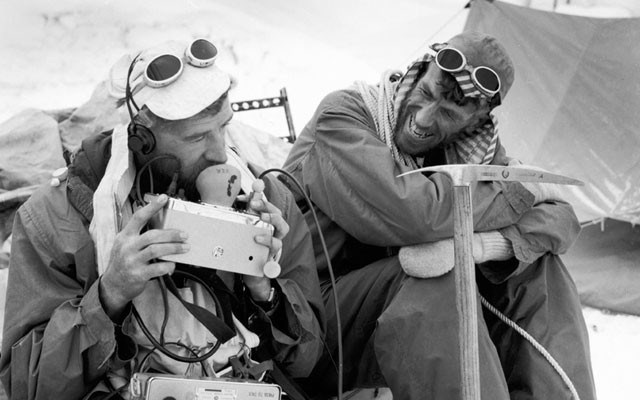There's been so many accounts of the first ascent of Mount Everest in the 60 years since Edmund Hillary and his fellow climbers reached the iconic summit that one would think there's little left to learn about one of the 20th century's greatest triumphs.
So when Dr. Huw Lewis-Jones got the chance to spend time with George Lowe — the last surviving member of that first Everest expedition until his death at the age of 89 in March — it was a dream come true for the award-winning historian and author.
"It was a huge honour. As a historian, you very rarely get the chance to meet the people you're writing about let alone meet the people that you really admire," said Lewis-Jones. "The best kind of history is when you can actually speak to the people who were there every step of the way."
Lewis-Jones first met Lowe at a 2003 event celebrating the 50th anniversary of the first summit, where some of the 15-man expedition was in attendance. After befriending Lowe and his family, Lewis-Jones was asked to help author the climber's memoir and photography book, The Conquest of Everest: Photographs of the Legendary First Ascent.
Lewis-Jones, an avid mountaineer and former curator at the National Maritime Museum in London, spent hours speaking with Lowe and his family, pouring over unpublished photographs, letters and other rare expedition material from the first successful expedition.
The book, which has garnered tremendous sales in the U.K. and earned the Mountaineering History Award at the 2013 Banff Mountain Film and Book Festival, offers readers a fresh and personal perspective on the conquering of the world's highest peak.
But even with Lowe's many achievements — he also served as the official photographer for the first overland crossing of Antarctica in 1958 — Lewis-Jones was amazed by the New Zealander's humility.
"George was of a generation who accomplished tremendous, amazing exploration achievements, but he didn't really shout about it. He was a tremendously modest man," he said.
The abundance of letters — Lowe wrote from Everest to his mother or sister on an almost daily basis during the expedition — led to a second book Lewis-Jones helped author, Letters from Everest: A First-Hand Account from the Epic First Ascent.
The curator was struck by the passion Lowe so clearly had for the mountains, even while battling treacherous conditions while pioneering the first route up the Lhotse Face, a steep, icy slope along the traditional southeastern path to Everest.
"For 10 days he was basically cutting ice by hand with a long angler knife, but was having the time of his life," he said. "You read the letters and it's just sheer joy that you find, and I haven't really seen many other expeditions like that today."
There were, of course, a few other aspects of Lowe's expedition that were markedly different from the Everest climbs of today.
With the trip's official photographer falling ill partway through the ascent, Lowe took on his duties, keeping his camera with him in his sleeping bag at night so it wouldn't freeze in the frigid high-altitudes. He even taught his good friend and fellow kiwi Hillary how to use his Kodak camera.
"They didn't develop any film on the mountain so they had no idea whether any of the photographs would come out," Lewis-Jones said. "They didn't know if that classic shot that Hillary took of (sherpa) Tenzing Norgay on the top would come out."
And even though their expedition would eventually inspire a media frenzy the world over, Lewis-Jones said it was clear during his research that the climbers didn't let their newfound fame go to their heads.
"I can't judge why people would climb Everest today, but these guys were really great mountaineers, but not just doing it for the fame or for the glory, they were just doing it for the love of the mountains," he said. "This is where they wanted to be."
Lewis-Jones will be at the Whistler Public Library Tuesday (Nov. 5) at 7:30 p.m. to discuss his book, followed by a Q&A period. The event is free.




